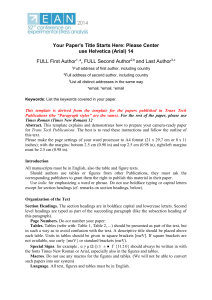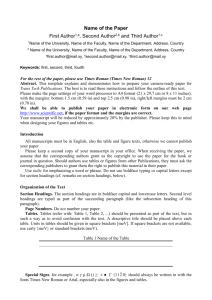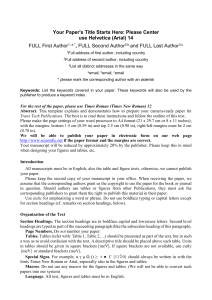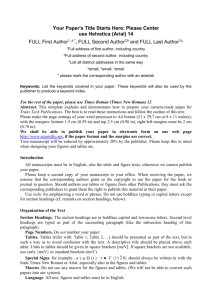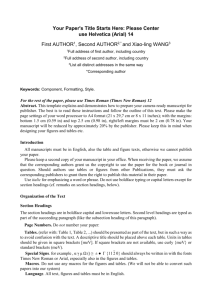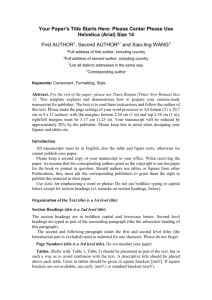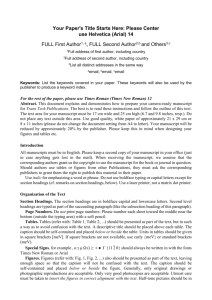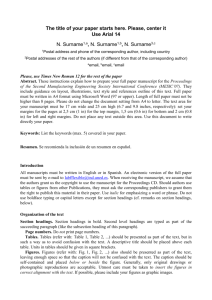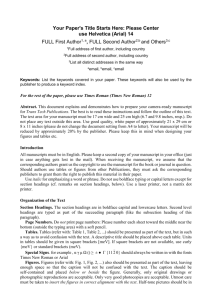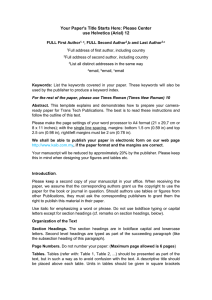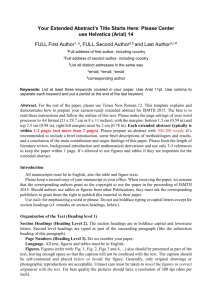Full Paper (Download template here)
advertisement
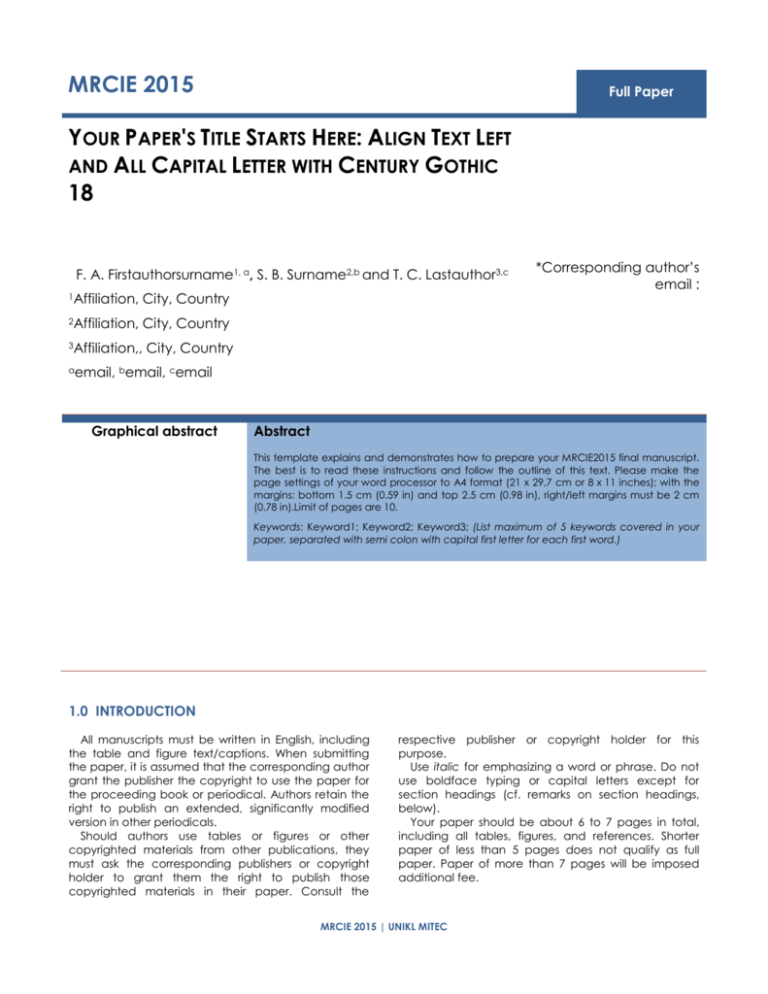
MRCIE 2015
Full Paper
YOUR PAPER'S TITLE STARTS HERE: ALIGN TEXT LEFT
AND ALL CAPITAL LETTER WITH CENTURY GOTHIC
18
F. A. Firstauthorsurname1, a, S. B. Surname2,b and T. C. Lastauthor3,c
1Affiliation,
City, Country
2Affiliation,
City, Country
3Affiliation,,
*Corresponding author’s
email :
City, Country
aemail, bemail, cemail
Graphical abstract
Abstract
This template explains and demonstrates how to prepare your MRCIE2015 final manuscript.
The best is to read these instructions and follow the outline of this text. Please make the
page settings of your word processor to A4 format (21 x 29,7 cm or 8 x 11 inches); with the
margins: bottom 1.5 cm (0.59 in) and top 2.5 cm (0.98 in), right/left margins must be 2 cm
(0.78 in).Limit of pages are 10.
Keywords: Keyword1; Keyword2; Keyword3; (List maximum of 5 keywords covered in your
paper, separated with semi colon with capital first letter for each first word.)
1.0 INTRODUCTION
All manuscripts must be written in English, including
the table and figure text/captions. When submitting
the paper, it is assumed that the corresponding author
grant the publisher the copyright to use the paper for
the proceeding book or periodical. Authors retain the
right to publish an extended, significantly modified
version in other periodicals.
Should authors use tables or figures or other
copyrighted materials from other publications, they
must ask the corresponding publishers or copyright
holder to grant them the right to publish those
copyrighted materials in their paper. Consult the
respective publisher or copyright holder for this
purpose.
Use italic for emphasizing a word or phrase. Do not
use boldface typing or capital letters except for
section headings (cf. remarks on section headings,
below).
Your paper should be about 6 to 7 pages in total,
including all tables, figures, and references. Shorter
paper of less than 5 pages does not qualify as full
paper. Paper of more than 7 pages will be imposed
additional fee.
MRCIE 2015 | UNIKL MITEC
2
AUTHORS&CO-AUTHORS NAME
2.0 EXPERIMENTAL
printed in full color and make the necessary
payments in advance.
Section Headings. The section headings are in
boldface capital and lowercase letters. Second level
headings are typed as part of the succeeding
paragraph (like the subsection heading of this
paragraph).
3.0 RESULTS AND DISCUSSION
Tables. Tables (refer with: Table 1, Table 2, ...)
should be presented as part of the text, but in such a
way as to avoid confusion with the text. A descriptive
title should be placed above each table. Units in
tables should be given in square brackets [meV]. If
square brackets are not available, use curly {meV} or
standard brackets (meV). Omit the vertical lines for
the table.
Table 2. This is the caption for this table.
Input
Varia
ble 1
Varia
ble 2
Outpu
t
1
(MPa)
Outpu
t 2 (%)
Out
put 3
(unit)
0.07
1
0.07
0.06
1
0.06
Out
put 4
(unit)
97.2
6
2
77.6
Out
put 5
(unit)
<
0.01
<
0.01
Special Signs. for example , α γ μ Ω () ≥ ± ● Γ {11 2
0} should always be written in with the fonts Times
New Roman or Arial, especially also in the figures and
tables.
Macros. Do not use any macros for the figures and
tables. (The Publisher’s system is not compatible with
such setting)
Language. All text, figures and tables must be in
English.
Figures. Figures (refer with: Fig. 1, Fig. 2, ...) also
should be presented as part of the text, leaving
enough space so that the caption will not be
confused with the text. The caption should be selfcontained and placed below or beside the figure.
Generally, only original drawings or photographic
reproductions are acceptable. Only very good
photocopies are acceptable. Utmost care must be
taken to insert the figures in correct alignment with
the text. Half-tone pictures should be in the form of
glossy prints. If possible, please include your figures as
graphic images in the electronic version. For best
quality the pictures should have a resolution of at
least 300dpi (dots per inch). Color figures are
welcome for the online version of the journal.
Generally, these figures will be converted to black
and white for the print version. The author should
indicate on the checklist if he wishes to have them
a
b
Fig. 1. Image of the picture (a) on the left and (b)
on the right.
Equations. Equations (refer with: Eq. 1, Eq. 2, ...)
should be indented 5 mm (0.2"). There should be one
line of space above the equation and one line of
space below it before the text continues. The
equations have to be numbered sequentially, and
the number put in parentheses at the right-hand
edge of the text. Equations should be punctuated as
if they were an ordinary part of the text. Punctuation
appears after the equation but before the equation
number, e.g.
c2=a2+b2
(1)
4.0 CONCLUSION
Literature References
References are cited in the text just by square
brackets [1]. (If square brackets are not available,
slashes may be used instead, e.g. /2/.) Two or more
references at a time may be put in one set of
brackets [3,4]. The references are to be numbered in
the order in which they are cited in the text and are
to be listed at the end of the contribution under a
heading References, see our example below.
Acknowledgement
You may put acknowledgments (to persons or
funding agencies) here.
References
[1] J. van der Geer, J.A.J. Hanraads, R.A. Lupton,
The art of writing a scientific article, J. Sci. Commun.
163 (2000) 51-59.
Reference to a book:
[2] W. Strunk Jr., E.B. White, The Elements of Style,
third ed., Macmillan, New York, 1979.
3
AUTHORS&CO-AUTHORS NAME
Reference to a chapter in an edited book:
[4]
P.G. Clem, M. Rodriguez, J.A. Voigt and C.S.
Ashley, U.S. Patent 6,231,666. (2001)
[3] G.R. Mettam, L.B. Adams, How to prepare an
electronic version of your article, in: B.S. Jones, R.Z.
Smith (Eds.), Introduction to the Electronic Age, EPublishing Inc., New York, 1999, pp. 281-304.
[5] Information on http://www.weld.labs.gov.cn
accessed on 6 May 2013.
